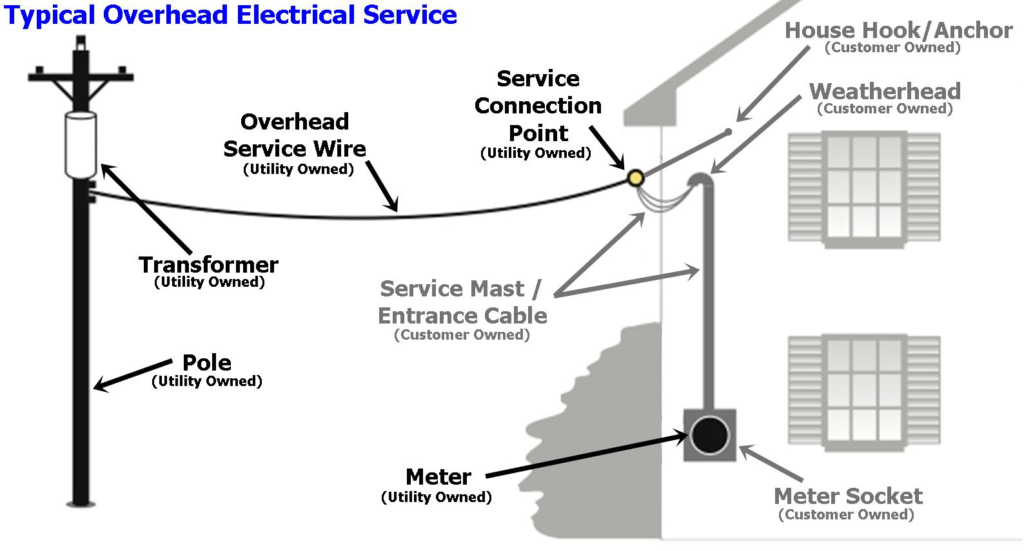From ASHI Electrical Power Booklet
In order for an electrical system to be safe, it must be properly installed according to the requirements of the National Electrical Code®and any local regulations. Licensed electricians follow the code when they install, repair or improve electrical circuits inside a house.

The National Electrical Code is revised every three years in response to changes in the understanding of electrical safety and to accommodate new materials and devices. As a result, any home more than three years old probably doesn’t comply with one or more provisions of the current code.
The National Electrical Code is revised every three years in response to changes in the understanding of electrical safety and to accommodate new materials and devices. As a result, any home more than three years old probably doesn’t comply with one or more provisions of the current code.
In older neighborhoods or rural areas, the utility company provides power to homes through overhead conductors called the service drop. In urban areas and newer neighborhoods, the power comes to the house underground and is called a service lateral.
Typically, the homeowner is responsible, through his or her electrical contractor, for maintaining the electrical system throughout the house up to the utility company connections (usually immediately before the meter).
Size of the service
Many factors determine the available amperage to a home. An electrician or an ASHI member can tell you how many amps your electrical system is set to provide.
With the heavy electrical demand of today’s lifestyles, any service which provides less than 100 amps at 120/240 volts may be considered inadequate for any home, except a small apartment or condominium. A home equipped with modern appliances, such as an electric water heater, range, clothes dryer and central air conditioning, may require 150 amps. If, in addition, the house is heated by electricity or has addi- tional electric appliances, it may require zoo-amp or greater service.
If an electrical service has not been upgraded within the last 40-50 years, the chances are that the amount of power being supplied is inadequate. An inadequate service may have:
- fuses that blow or circuit breakers that trip often,
- lights that flicker or dim when appliances are turned on,
- a TV image that shrinks when a heavy appliance is turned on, or
- too many extension cords in use.
The electric meter
Electrical usage is measured in units called watts, which are equivalent to the number of volts times the number of amps. The utility company charges you according to the number
of watts that are registered on the digital readout or dials of your electric meter. The meter itself, which belongs to the utility, may be located inside or outside the house.
Main distribution panel
The main distribution panel is the heart of the electrical system. It is usually located on a wall near the incoming service entrance wire. The service disconnect can be an integral part of this panel or it can be in a separate panel near the meter. The National Electrical Code allows up to six disconnects to shut of fall the power in a house. It is essential homeowners know the location of all service disconnects and understand how to use them in the event of an emergency.
Overload protection
When too much current flows through a wire, the wire gets hot, sometimes hot enough to destroy the insulation and cause a fire.
This situation, called an overload, may develop from a short circuit, where two bare wires are touching each other or, more frequently,when too many appliances are being used on the same circuit at one time.
To prevent this from happening, the wires in a circuit are protected with safety devices designed to open, or disconnect, the circuit from its source when too much current is passing through them.
There are two kinds of overcurrent protective devices: fuses, which must be replaced if they blow, and circuit breakers, which can be reset.
Once the cause of the overload has been corrected (e.g., by unplugging some of the
devices, or by replacing worn insulation or defective appliances), circuit breakers can be
reset by moving the switch from the “trip” position to “off’ and then back to “on.” Even if they
are never tripped, all circuit breakers should be turned off and on at least once a year to prevent sticking due to corrosion buildup or mechanical failure of their moving parts.
Since blown fuses must be replaced, it always helps to have a supply of the correct sizes on hand.
A word about fuse and breaker size
The National Electrical Code®specifies the maximum current of amperage that can be carried safely by each size and type of wire used in a home. Therefore, fuses and breakers must be the correct amperage in order to properly protect each circuit. In other words, if you blow a 15-amp fuse, it should be replaced only with a 15-amp fuse or a Type S (tamper proof) 15-amp fuse and adapter. Larger size fuses would allow too much current to flow in the circuit, making it unsafe.
Service ground
Every electrical system must be grounded so that electricity from a lightning strike or a power surge will be harmlessly discharged into the earth rather than into the house system or a person. System grounding is achieved by connecting the neutral wires from all the electrical circuits to a grounding rod, a buried metal water supply pipe or the reinforcing steel in a building’s concrete foundation.


